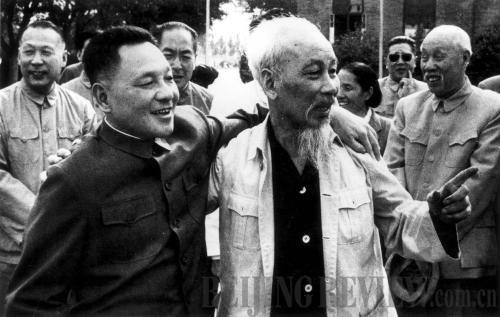|
Comprehensive development
 |
|
BROTHERLY FAREWELL: Chinese leader Deng Xiaoping bids goodbye to visiting Vietnamese President Ho Chi Minh in May 1965 (CNSPHOTO) |
In February 1999, Le Kha Phieu, Secretary General of the Central Committee of the Communist Party of Viet Nam, visited China. Both sides signed a joint statement reiterating the principles and consensus reached since the normalization of relations. It was a historic new moment for Sino-Vietnamese relations.
All these set the stage for a series of agreements on border issues. In December 1999, a land boundary treaty was signed. Then on November 18, 2009, the China-Viet Nam Land Border Demarcation Protocol was signed into law, officially demarcating contested areas.
Nine years earlier, in December 2000, a series of vital, comprehensive documents were signed. These included an agreement over the delineation of the territorial sea, exclusive economic zone and continental shelf in Beibu Gulf. Other agreements focused on issues including fishery cooperation in the Beibu Gulf, which later fully entered into force, coupled with final resolutions of border disputes in the region.
Since the beginning of the 21st century, Sino-Vietnamese relations have strengthened continually. Nong Duc Manh, General Secretary of the Central Committee of the Communist Party of Viet Nam, for example, visited China four times consecutively in 2001, 2003, 2006 and 2008.
It is worth noting that, during his 2008 visit, both countries announced a decision to develop a "comprehensive strategic partnership." Additionally, other major Vietnamese political figures—including Viet Nam's president, prime minister and the chairman of its National Assembly—also paid visits to China.
Chinese leaders have been equally vigilant in paying visit to their southern neighbor in recent years to augment ties. In 2002, then General Secretary of the Central Committee of the Communist Party of China and President Jiang Zemin visited Hanoi.
These meetings were further strengthened by a more recent visit by Hu Jintao, General Secretary of the Central Committee of the Communist Party of China and President, in October 2005.
Economic and trade cooperation has also blossomed at a rapid pace as a result. In fact, China is now Viet Nam's biggest trading partner. In 2008, China-Viet Nam trade volume reached $21 billion—up by 47 percent compared to 2007, having reached their stated goal two years in advance.
A new target has been set to reach a trade volume of $25 billion in 2010. Chinese investments in Viet Nam continue to increase, contributing greatly to Viet Nam's economic development. Indeed by the end of 2008, Beijing had invested in a total of 628 projects in Viet Nam with a total investment value at nearly $2.2 billion.
The two countries have also strengthened policies aimed at expanding entrepreneurship. This has been undertaken in the context of the China-ASEAN (Association of Southeast Asian Nations) Free Trade Area, and the Mekong sub-regional cooperation framework.
The communist parties of China and Viet Nam have also held five theoretical seminars in 2003, 2004, 2007, 2008 and 2009 with the aim of promoting mutual understanding—in particular with regard to political policies and development as well as efforts to address the world financial crisis.
Win-win prospects
There is an old Chinese proverb that a friendly neighbor is preferable to a distant cousin. But Viet Nam is both a close neighbor and a close relative. Since full normalization in 1991 capped a 60-year history, remarkable achievements have been realized.
But differences remain. The most prominent revolves around the territorial disputes over the South China Sea. China has indisputable sovereignty over the islands of the South China Sea, and their adjacent waters. With hope, however, both sides will be able to come to a resolution.
China and Viet Nam are nations of significant influence in Asia—thus their mutual interests must be regarded as essential to a harmonious Asia with lasting peace and common prosperity. Their friendly relationship is one that should be capitalized upon and, thus, passed along to further generations.
The author is an assistant research fellow with the China Institutes of Contemporary International Relations | 